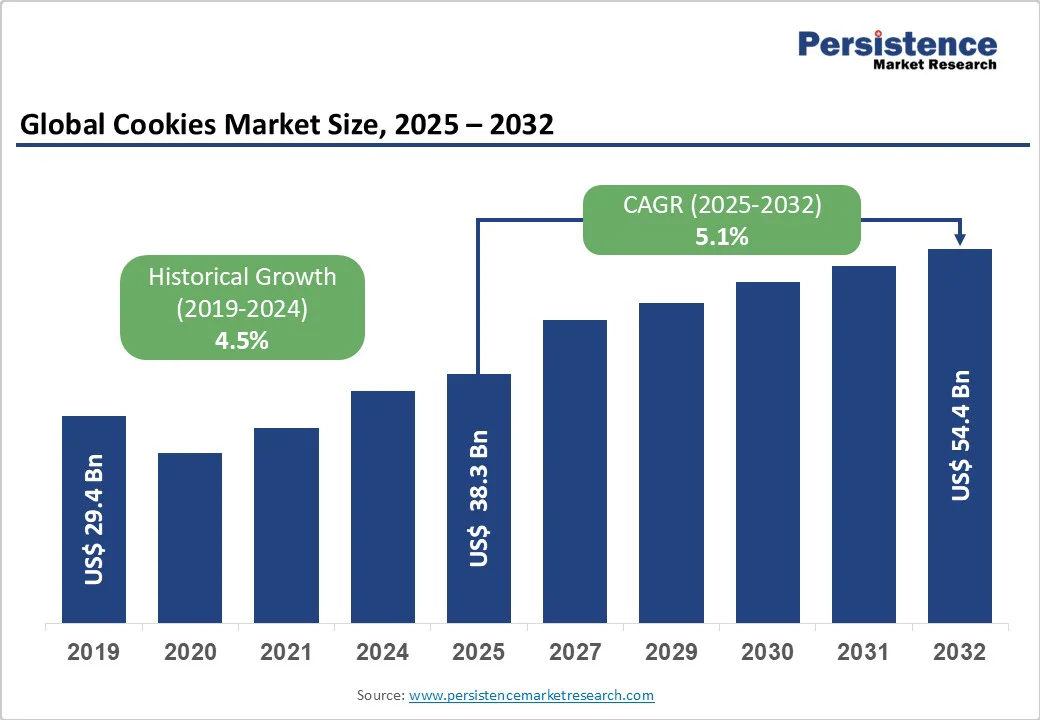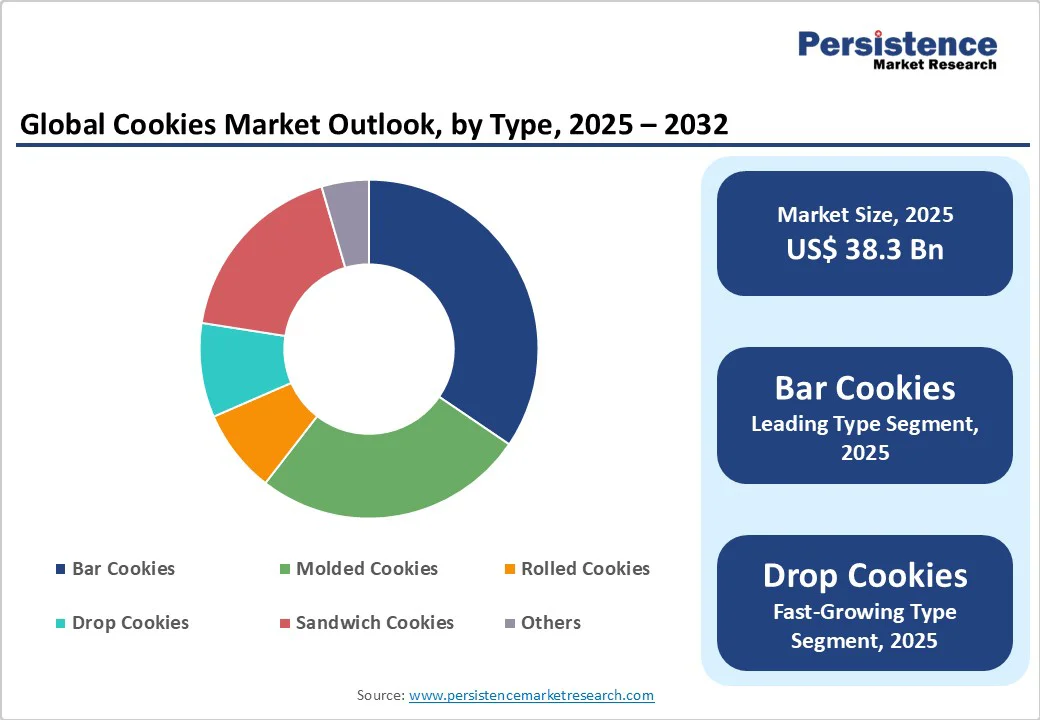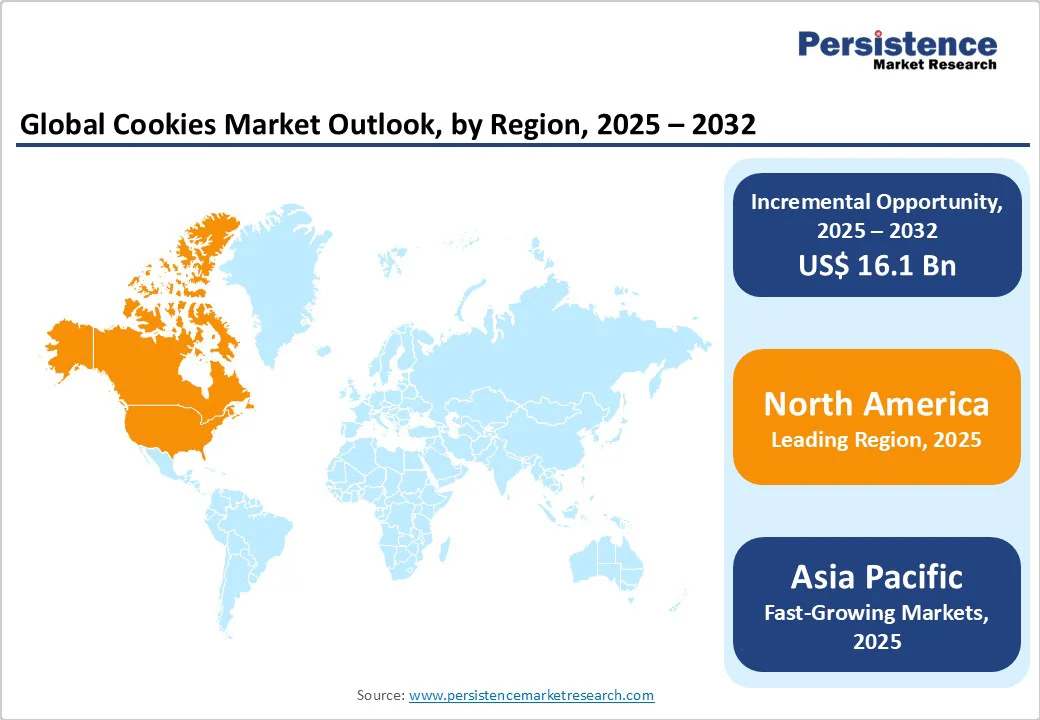ID: PMRREP18610| 196 Pages | 27 Oct 2025 | Format: PDF, Excel, PPT* | Food and Beverages

The global cookies market size is likely to be valued at US$ 38.3 billion in 2025, and is projected to reach US$ 54.4 billion by 2032, growing at a CAGR of 5.1% during the forecast period 2025 - 2032.
The market is witnessing steady growth driven by rising snacking culture, premiumization, and health-focused innovations. Consumers increasingly prefer convenient, indulgent, and functional snacks with clean labels and natural ingredients.
Soaring demand for gluten-free, high-fiber, and low-sugar cookies, along with the expansion of e-commerce channels, is reshaping market dynamics. Innovation in flavors, packaging, and portion sizes continues to define evolving consumer preferences worldwide.
| Key Insights | Details |
|---|---|
| Cookies Market Size (2025E) | US$ 38.3 Bn |
| Market Value Forecast (2032F) | US$ 54.4 Bn |
| Projected Growth (CAGR 2025 to 2032) | 5.1% |
| Historical Market Growth (CAGR 2019 to 2024) | 4.5% |

The cookies market keeps growing because people nowadays eat snacks more often instead of sitting down for proper meals. Modern life has become incredibly fast-paced everyone is rushing between work, school, and personal commitments. This leaves little time for cooking or eating traditional meals.
Cookies offer a perfect solution as they are ready to eat, easy to carry, and can be consumed anywhere and at any time. Working professionals especially prefer cookies as quick breakfast options or afternoon pick-me-ups. Students grab cookie packets between classes. Even families choose cookies for convenient evening snacks while watching television. The packaging is designed to maintain freshness, making cookies shelf-stable for weeks.
Manufacturers have smartly responded by creating a variety of flavors, such as chocolate chip, oatmeal, butter cookies, cream-filled options, and more. Health-conscious variants with whole grains, reduced sugar, or added nutrients now exist too.
According to the U.S. Department of Agriculture (USDA) Economic Research Service data, Americans' snacking frequency increased significantly, with snacks now contributing about 24% of daily calorie intake, up from previous decades, demonstrating this fundamental shift in eating patterns that directly benefits the cookies industry.
The biggest challenge facing cookie manufacturers is the growing awareness about health problems linked to sugary foods. Cookies traditionally contain high amounts of sugar, refined flour, and unhealthy fats. Medical research increasingly connects these ingredients to obesity, diabetes, heart disease, and other serious conditions, prompting governments worldwide to take action.
For example, countries such as the U.K., Mexico, and South Africa have introduced sugar taxes, making cookies more expensive for consumers. Packaging now must display nutritional labels prominently, and some regions require warning labels on high-calorie products.
Schools have banned or restricted cookies from cafeterias and vending machines. Public health campaigns actively discourage consumption of processed snacks. This negative perception has forced companies to invest heavily in developing healthier alternatives while maintaining taste, which has increased costs.
There is an enormous potential for companies willing to reinvent cookies as healthy snacks. Consumers increasingly want foods that taste good but also provide nutritional benefits. This opens doors for creative product development. For example, manufacturers can use alternative sweeteners such as stevia, monk fruit, or dates instead of refined sugar.
They can also incorporate whole grain flour, oats, quinoa, or almond flour for better nutrition. Adding protein through ingredients such as whey, nuts, or seeds transforms cookies into more satisfying snacks. Some companies are successfully including superfoods such as chia seeds, flaxseeds, or dark chocolate with high cocoa content.
Functional cookies represent another exciting direction - products designed for specific purposes, such as energy-boosting cookies with caffeine for athletes, probiotic cookies for digestive health, or cookies enriched with vitamins and minerals for children.
Bar cookies are expected to account for nearly 35% of global market revenues in 2025, maintaining their dominance due to on-the-go convenience, portion control, and consistent quality. Their uniform texture and shape make them ideal for mass production and long shelf life, appealing strongly to both manufacturers and retailers.
Segmental growth is further supported by consumer demand for nutrient-rich and functional snack options, incorporating ingredients such as nuts, oats, seeds, and protein blends. These value-added formulations cater to evolving preferences for energy-boosting and wholesome snacks, particularly among urban and working populations.
With growing adoption across supermarkets, cafés, and online retail channels, bar cookies continue to bridge the gap between indulgence and nutrition. Their versatility and evolving formulations cater to both health-conscious and taste-driven consumers, underscoring their rising significance in the global cookies landscape.
The chocolate segment is set to continue to dominate in 2025, contributing over 25% of the cookies market revenue share in 2025. The timeless appeal of chocolate across age groups and regions makes it an indulgent favorite, fueled by growing consumer preference for premium and flavored varieties.
Similarly, chocolate chip cookies, holding around 20% of the total market share, remain highly popular due to their rich taste and versatility. Asia Pacific plays a crucial role in driving demand, supported by expanding modern retail network, and a young, urban consumer base increasingly drawn to convenient snacks.
Alongside chocolate, oatmeal is poised to emerge as the fastest-growing ingredient from 2025 to 2032, driven by the global shift toward healthier snacking options rich in fiber and whole grains.
Oatmeal cookies serve as a nutritious alternative to traditional chocolate and chocolate chip varieties, appealing strongly to health-conscious consumers seeking balanced indulgence. Their position as a wholesome yet tasty snack aligns with the preferences of individuals pursuing active and well-oriented lifestyles, boosting their popularity in the evolving market for cookies.

North America is expected to dominate the cookies market share, powered by its mature consumer base and sophisticated retail landscape. The U.S. leads consumption, where cookies remain deeply embedded in food culture from after-school snacks to office break rooms. Americans favor indulgent varieties such as double chocolate and peanut butter cookies alongside healthier options. Major brands continuously launch limited-edition flavors to maintain consumer excitement.
Canada shows growing preference for organic and natural cookies, with consumers actively reading ingredient lists before purchasing. Canadian shoppers increasingly support local bakeries and regional brands over multinational corporations. Both countries witness rising demand for portion-controlled packaging - individually wrapped cookies help consumers manage calorie intake while enjoying treats.
Asia Pacific is forecasted to be the fastest-growing regional market for cookies, propelled by rapid economic development, improving discretionary spending habits, and evolving consumer lifestyles. In China, growth is propelled by an expanding urban population adopting Western snacking habits.
Young professionals increasingly purchase premium imported cookies as part of their daily indulgences, while local brands cater to mass-market affordability, balancing taste and accessibility. The market also benefits from increasing online retail penetration, enabling convenient access to a wide variety of cookie products.
In India, the cookies market is experiencing significant expansion due to changes in family structures, with nuclear families fueling demand for packaged snacks. Consumers show a strong preference for sweet and heavily flavored cookies, with traditional tastes such as cardamom, saffron, and cashew performing exceptionally well.
Combined with growing urbanization, rising health awareness, and digital marketing reach, both China and India are pivotal in shaping Asia Pacific’s dynamic cookies market, offering substantial growth opportunities for local and international players.

The global cookies market landscape exhibits moderate to high competition, dominated by multinational players such as Mondelez International, Inc., Nestlé S.A., Grupo Bimbo, Kellogg’s, and Britannia Industries Limited. These companies leverage brand strength, extensive distribution networks, and product innovation to maintain leadership.
Focus areas include premiumization, health-oriented variants (low sugar, gluten-free, high-fiber), new flavors, functional ingredients, and packaging innovations. Regional and local producers, especially in Asia and Latin America, compete by tailoring flavors, pricing, and pack sizes to local preferences. Growing online retail adoption further drives competitive differentiation, enabling faster consumer reach and responsiveness to evolving snacking trends.
The global cookies market is projected to reach US$ 38.3 billion in 2025.
Surging consumer demand for convenient snacks, health-conscious eating habits, and the rise of online retail channels are driving market growth.
The market is poised to witness a CAGR of 5.1% between 2025 and 2032.
Expansion of online retail, product innovation, and rising demand for healthier and premium cookies offer significant expansion opportunities.
Some of the top market companies are Nestlé S.A., Mondelez International, Inc., United Biscuits (UK) Limited Co., and Grupo Bimbo.
| Report Attributes | Details |
|---|---|
| Historical Data/Actuals | 2019 - 2024 |
| Forecast Period | 2025 - 2032 |
| Market Analysis | Value: US$ Bn/Mn, Volume: As Applicable |
| Geographical Coverage |
|
| Segmental Coverage |
|
| Competitive Analysis |
|
| Report Highlights |
|
By Product Type
By Ingredient
By Distribution Channel
By Region
Delivery Timelines
For more information on this report and its delivery timelines please get in touch with our sales team.
About Author